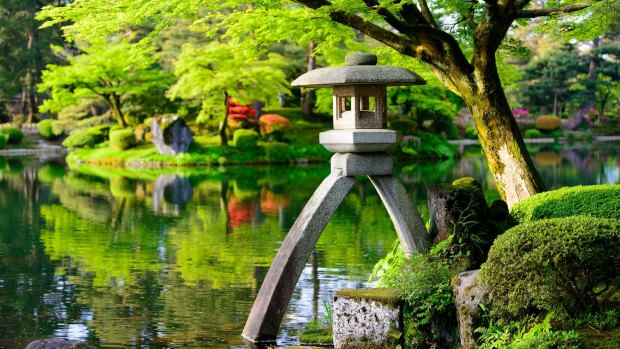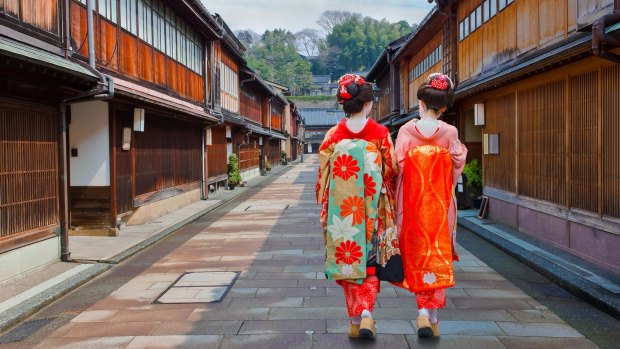This was published 4 years ago
Why Japan's cultured Kanazawa, or 'Little Kyoto', is an emerging traveller hotspot
By Sarah Maguire

One of Japan's "great three" gardens, Kenrouk-en, established by the Maedas in their castle grounds in the mid-17th century.Credit: Alamy
Back in the day, the powerful feudal lords of Kanazawa kept their heads down and samurai swords sheathed to ensure peace with the shoguns who ruled Japan from Edo Castle, 500 kilometres away in today's Tokyo.
The strategy worked, and led to a blossoming of high culture. For 300 years the Maeda family channelled their wealth into pursuits other than building military might. Arts, crafts, tea ceremonies and cuisine came to define Kanazawan life while also serving to show the shogunate that their super rich, one-time enemies were more interested in lacquerware and porcelain than civil war.
So here I am, forking out ¥1000 (about $13) for a soft-serve ice-cream dipped in gold leaf, a lustrous, sweet nod to the pre-eminence of gold leaf in Kanazawa, which is the national capital of both its production and the beautiful things artisans do with it.

Japanese Geisha at Higashi-Chaya-gai - Geisha District in Kanazawa.Credit: Alamy
The shop I've bought it from is one of a row running alongside one of Japan's "great three" gardens, Kenrouk-en, established by the Maedas in their castle grounds in the mid-17th century and where, on our springtime visit, apricot trees are blooming and the cherry trees won't be far behind.
We've already visited Omichi market, the city's "kitchen" since 1721 and a showcase of the specialty Kaga vegetables and abundant fresh seafood that are also among Kanazawa's claims to fame.
A wander around the Geisha District of Higashi Chaya-Gai is still ahead of us, as is shopping for some of the 22 traditional Kanazawa crafts that have made it part of the UNESCO Creative Cities Network, and a hands-on craft experience with a sheet of gold leaf that is a mere .0001 millimetres thick.
There's a lot going on in this city on the Sea of Japan, population 465,000. Dubbed "Little Kyoto" for its troika of samurai, geisha and artisan heritage, domestic tourists flock here, but it flies largely under the radar of foreign travellers. You get the sense that may be changing; that Kanazawa is in a get-there-before-the-crowds moment.
It used to take five hours, and more than one train, to reach it from Tokyo. Then, in 2015, a direct 2 ½-hour Shinkansen train service began, to the unabashed joy of the locals. "The first bullet train was in 1964, between Tokyo and Osaka, so it took us 50 years to get one - you can imagine how excited we were," says our tour guide, Keko.
Train passengers arrive at a landmark station the entrance to which is a soaring 30 metre-high glass "welcome" dome fronted by a vermilion-hued Drum Gate which is modelled on a traditional tsuzumi hand drum. The spectacular affair is designed to protect emerging visitors from the wet - it rains here 193 days a year, and snowfall is heavy too, but don't let that put you off; Kanazawans work hard to stay dry (complimentary umbrella stations around the city operate on a trust system) and cosy (more on its tiny-bar scene below). And the run-off from the verdant region is one of the reasons the Sea of Japan's waters are so nutrient-rich, and consequently why Kanazawa seafood is renowned.
Cruise ship visits are also on the rise with more than 50 scheduled to dock this year, many of them for turnarounds. A new three-storey Kanazawa Port cruise terminal, able to handle 4000 passengers in two hours, is due for completion in March next year.
Kanazawa is the last port of call on our Botanica World Discoveries' 12-day Cherry Blossoms, Culture and Sights of Japan cruise and the ship, the MS Caledonian Sky, will be welcoming a new group of passengers before heading back the way we've just come.
I've cruised in with about 70 fellow passengers, mostly Australians. As we disembark for a day of sightseeing, we are greeted by a line of smiling women in pastel-coloured kimono, some of the 6500-plus members of the Cruise Welcome Club of Kanazawa Port.
The city's main attractions are a short drive from the port – Kanazawa, the capital of Ishikawa prefecture on central Honshu Island, is a compact little gem with a layout largely unchanged in 500 years, having escaped major earthquakes and the Allied World War II firebombing that destroyed many other Japanese cities.
Higashi Chaya-Gai is one neighbourhood – the Naga-machi samurai district is another – where you can see first-hand why Kanazawa is one of the best-preserved of Japan's Edo-era castle towns.
Once the grandest pleasure district outside Kyoto and Tokyo, with 200 geisha houses, the wooden lattice-fronted buildings of Higashi Chaya-Gai now house upmarket cafes, expensive craft galleries and antique stores, as well as the remaining seven tea houses where geisha still perform.
Keko tells us there are nearly 50 working geisha in town, the oldest of them 84. We'll be lucky to see any of them as we stroll around the immaculately kept precinct. The geisha are notoriously elusive, but you can secure an entrée into their enigmatic world by booking a Geisha Evening at the Kaikaro teahouse ( ¥10,000 will get you a front-row seat), where the English-speaking landlady promises to reveal geisha secrets and a Kanazawa Geisha play is performed.
Come night time, I'm yanked out of the Edo era and onto a dining stool at one of Kanazawa's best sushi bars in the main downtown district of Kata-machi, which centres on a neon-lit crossroads known as the scramble. At Sushi Ippei, which has been in business for 65 years, there's room for no more than a dozen diners along the counter. The sushi is made to order from great slabs of raw fish under glass right in front of you, and placed directly onto a black marble bench above the counter for diners to pick up and transfer to their plates.
Run by a husband and wife team of chef and maître d', it's a convivial spot and strangers inevitably start to chat over their sweet shrimp, crab and mackerel sushi.
The evening gets even cosier as we head to the bar-lined, shanty-like Shintenchi alleyway in Kata-machi. Behind colourful noren curtains are miniscule sanctuaries from the night-time chill. Our first stop, the bar Hanazato, has seating room for no more than six, and fills with cooking smoke as the hostess, a veteran of 40 years in hospitality, prepares pork skewers and serves us glasses of sake in lacquered-wood boxes. We duck behind the noren at Beerdaru BJ, further down the alleyway, for beer and peanuts in an equally warm and tiny space, far too sated by now to try anything from a menu offering the likes of pizza and camembert baguette.
When we board the bullet train for Tokyo the next morning, Kanazawa feels like unfinished business. There are temples, shrines and hot springs that I haven't got anywhere near, an acclaimed 21st century Museum of Contemporary Art to visit, more shopping, eating and exploring to be done. We have had only 24 hours in "Little Kyoto". It's not nearly long enough.
TRIP NOTES
MORE
CRUISE
Botanica World Discoveries has autumn and spring small-ship cruises in Japan that feature Kanazawa in their itineraries. The 12-day Cherry Blossom, Culture and Sights of Japan cruise on the MS Caledonian Sky departs March 20 from Osaka and costs from $16,590 a person, air fares not included. See botanica.travel
Sarah Maguire was a guest of of Botanica World Discoveries.
Sign up for the Traveller Deals newsletter
Get exclusive travel deals delivered straight to your inbox. Sign up now.